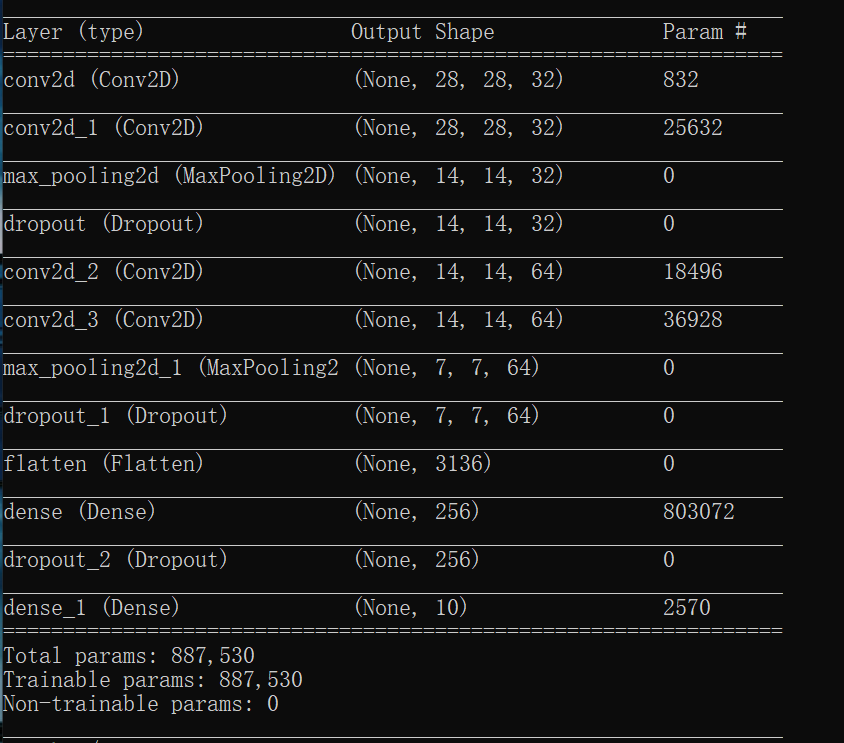树莓派基于tensorflow的数字识别
树莓派基于tensorflow的数字识别
目前博主只试过python3.7.3+tensorflow1.13.1版本,其它tensorflow版本的还没试
一、安装tensorflow环境
-
检查python环境
1 python3 --version 2 pip3 --version
-
更新软件源
sudo apt update
sudo apt upgrade
-
执行安装相应环境
1 sudo apt-get install python3-pip python3-dev
-
若使用pip3 install tensorflow==1.13.1安装可能需要等待漫长的时间,可以先在网上下载 tensorflow-1.13.1-cp37-none-linux_armv7l.whl,然后复制到树莓派系统上,再执行以下代码可以安装成功
1 sudo pip3 install tensorflow-1.13.1-cp37-none-linux_armv7l.whl
-
运行以下程序检验环境是否安装成功
import tensorflow as tf hello = tf.constant(“Hello, World!”) sess = tf.Session() print(sess.run(hello))
-
解决numpy和h5py的依赖
1 sudo apt install libatlas-base-dev 2 sudo apt install libhdf5-dev 3 sudo apt install python-h5py
-
安装numpy和h5py
1 sudo pip3 install h5py 2 sudo pip3 install numpy
-
配置opencv2环境
1 sudo apt-get install build-essential cmake git pkg-config 2 sudo apt install build-essential cmake git pkg-config libgtk-3-dev libcanberra-gtk* 3 sudo apt install libavcodec-dev libavformat-dev libswscale-dev libv4l-dev libxvidcore-dev libx264-dev 4 sudo apt install libjpeg-dev libpng-dev libtiff-dev gfortran openexr libatlas-base-dev opencl-headers 5 sudo apt install python3-dev python3-numpy libtbb2 libtbb-dev libdc1394-22-dev 6 sudo apt-get install libjpeg8-dev 7 sudo apt-get install libtiff5-dev 8 sudo apt-get install libjasper-dev 9 sudo apt-get install libpng12-dev 10 sudo apt-get install libavcodec-dev libavformat-dev libswscale-dev libv4l-dev 11 sudo apt-get install libgtk2.0-dev 12 sudo apt-get install libatlas-base-dev gfortran
-
安装opencv2
1 // 下载OpenCV 2 sudo apt-get install libopencv-dev 3 sudo apt-get install python-opencv
二、程序分析
-
项目文件结构,生成模型放置在model文件夹,测试数据集在testimage,训练数据集在trainimage,mnist.py为训练模型程序,main.py为部署模型程序
-
mnist.py部分程序分析
-
导入库(使用tensorflow框架)
1 # -*- coding: UTF-8 -*- 2 import tensorflow as tf 3 import tensorflow.keras as keras 4 from tensorflow.keras import Sequential 5 from tensorflow.keras.layers import Flatten, Dense, Conv2D, MaxPooling2D, Dropout, MaxPool2D 6 from tensorflow.keras.datasets import mnist 7 from tensorflow.keras import backend as K 8 import json
-
设置参数(batch_size为每次训练所选取的样本数,epochs为训练次数)
1 # 设置参数 2 batch_size = 128 3 num_classes = 10 4 epochs = 10 5 6 # 输入数据维度 7 img_rows, img_cols = 28, 28
-
- 加载数据集
1 # 加载数据集,调用库中已有mnist数据集from tensorflow.keras.datasets import mnist 2 (x_train, y_train), (x_test, y_test) = mnist.load_data() 3 4 if K.image_data_format() == 'channels_first': 5 x_train = x_train.reshape(x_train.shape[0], 1, img_rows, img_cols) 6 x_test = x_test.reshape(x_test.shape[0], 1, img_rows, img_cols) 7 input_shape = (1, img_rows, img_cols) 8 else: 9 x_train = x_train.reshape(x_train.shape[0], img_rows, img_cols, 1) 10 x_test = x_test.reshape(x_test.shape[0], img_rows, img_cols, 1) 11 input_shape = (img_rows, img_cols, 1) 12 13 x_train = x_train.astype('float32') / 255 14 x_test = x_test.astype('float32') / 255
-
构造神经网络模型(损失函数使用交叉熵损失函数,优化器使用adam,衡量模型指标为准确率)
1 # 构建网络 2 model = Sequential() 3 # 第一个卷积层,32个卷积核,大小5x5,卷积模式SAME,激活函数relu,输入张量的大小 4 model.add(Conv2D(filters=32, kernel_size=(5, 5), padding='Same', activation='relu', 5 input_shape=(28, 28, 1))) 6 model.add(Conv2D(filters=32, kernel_size=(5, 5), padding='Same', activation='relu')) 7 # 池化层,池化核大小2x2 8 model.add(MaxPool2D(pool_size=(2, 2))) 9 # 随机丢弃四分之一的网络连接,防止过拟合 10 model.add(Dropout(0.25)) 11 model.add(Conv2D(filters=64, kernel_size=(3, 3), padding='Same', activation='relu')) 12 model.add(Conv2D(filters=64, kernel_size=(3, 3), padding='Same', activation='relu')) 13 model.add(MaxPool2D(pool_size=(2, 2), strides=(2, 2))) 14 model.add(Dropout(0.25)) 15 # 全连接层,展开操作, 16 model.add(Flatten()) 17 # 添加隐藏层神经元的数量和激活函数 18 model.add(Dense(256, activation='relu')) 19 model.add(Dropout(0.25)) 20 # 输出层 21 model.add(Dense(10, activation='softmax')) 22 model.summary() 23 model.compile(loss='categorical_crossentropy', optimizer='adam', metrics=['accuracy'])
-
- 模型训练
1 model.fit(x_train, y_train, batch_size=batch_size,epochs=epochs,verbose=1,validation_data=(x_test, y_test)) 2 score = model.evaluate(x_test, y_test, verbose=0) 3 print('Test loss:', score[0]) 4 print('Test accuracy:', score[1])


-
模型及其参数保存(保存格式为h5)
1 with open('model.json', 'w') as outfile: 2 json.dump(model.to_json(), outfile) 3 4 model_file = 'model.h5' 5 model.save(model_file)
-
部署模型程序分析
-
导入库(numpy、tensorflow、matplotlib、cv2、picamera)
1 # -*- coding: UTF-8 -*- 2 import numpy as np 3 import tensorflow as tf 4 import tensorflow.keras as keras 5 from tensorflow.keras.preprocessing.image import img_to_array, load_img 6 import matplotlib.pyplot as plt 7 import matplotlib.image as mpimg 8 from PIL import Image 9 import cv2 10 import os 11 from picamera import PiCamera 12 from time import sleep
-
加载模型model.h5
1 #load model 2 model_file = './model/model.h5' 3 model_file = model_file 4 print(type(model_file)) 5 global model 6 model = keras.models.load_model(model_file)
-
调用picamera库来连接树莓派的摄像头,并通过摄像头拍摄一张分辨率为480*480的图片,将其保存至“/home/pi/Desktop/camera/tf_keras_mnist/image_28.jpg”
1 # 调用打开摄像头库 2 camera = PiCamera() 3 # 设置照片分辨率为480*480 4 camera.resolution = (480, 480) 5 camera.start_preview() 6 sleep(2) 7 camera.capture('/home/pi/Desktop/camera/tf_keras_mnist/image_28.jpg') 8 camera.stop_preview() 9 print("Collect Image Finish!") 10 img_file = './image_28.jpg'
-
读取“./image_28.jpg”位置的图片,并将其分辨率更改为28*28,使得满足模型参数输入要求
1 img_array = cv2.imread(img_file, cv2.IMREAD_GRAYSCALE) 2 resized_image = cv2.resize(img_array, (28, 28)) 3 4 img = Image.fromarray(np.uint8(resized_image)) 5 img.save('output.jpg') 6 img = mpimg.imread(img_file)
-
把28*28分辨率的图片通过img_to_array把其矩阵中的参数由整数值变为浮点数的数组,再把所得数组放进已训练好的模型中,最后将会输出一个预测值
1 img = img_to_array(load_img(img_file, target_size=(28, 28), color_mode="grayscale")) / 255. 2 img = np.expand_dims(img, axis=0) 3 code = model.predict_classes(img)[0] 4 print("Predict Result: ", code)
全代码区
1 # -*- coding: UTF-8 -*- 2 import numpy as np 3 import tensorflow as tf 4 import tensorflow.keras as keras 5 from tensorflow.keras.preprocessing.image import img_to_array, load_img 6 import matplotlib.pyplot as plt 7 import matplotlib.image as mpimg 8 from PIL import Image 9 import cv2 10 import os 11 from picamera import PiCamera 12 from time import sleep 13 14 #load model 15 model_file = './model/model.h5' 16 model_file = model_file 17 print(type(model_file)) 18 global model 19 model = keras.models.load_model(model_file) 20 21 22 def preditc(): 23 print("Get ready to capture images and place the camera") 24 count = 5 25 while count >= 1: 26 print("Count Down: ", count, "s") 27 count = count - 1 28 sleep(1) 29 30 # 调用打开摄像头库 31 camera = PiCamera() 32 # 设置照片分辨率为480*480 33 camera.resolution = (480, 480) 34 camera.start_preview() 35 sleep(2) 36 camera.capture('/home/pi/Desktop/camera/tf_keras_mnist/image_28.jpg') 37 camera.stop_preview() 38 print("Collect Image Finish!") 39 img_file = './image_28.jpg' 40 41 img_array = cv2.imread(img_file, cv2.IMREAD_GRAYSCALE) 42 resized_image = cv2.resize(img_array, (28, 28)) 43 44 img = Image.fromarray(np.uint8(resized_image)) 45 img.save('output.jpg') 46 img = mpimg.imread(img_file) 47 48 img = img_to_array(load_img(img_file, target_size=(28, 28), color_mode="grayscale")) / 255. 49 img = np.expand_dims(img, axis=0) 50 code = model.predict_classes(img)[0] 51 print("Predict Result: ", code) 52 53 plt.imshow(np.real(img).squeeze()) 54 plt.show() 55 56 57 # 主函数 58 if __name__ == '__main__': 59 preditc()

